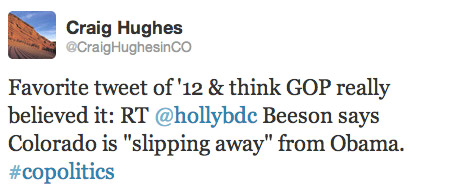
DEMOCRATS
REPUBLICANS
95%
5%

(D) J. Hickenlooper*
(R) Somebody
80%
20%


(D) M. Dougherty
(D) Jena Griswold
(D) Brian Mason
60%↑
30%↑
20%↓


(D) Brianna Titone
(R) Kevin Grantham
(D) Jerry DiTullio
60%↑
30%
20%↓

(D) Diana DeGette*
(R) Somebody
90%
2%

(D) Joe Neguse*
(R) Somebody
90%
2%

(R) Jeff Hurd*
(D) Somebody
80%
40%

(R) Lauren Boebert*
(D) Somebody
90%
10%

(R) Jeff Crank*
(D) Somebody
80%
20%

(D) Jason Crow*
(R) Somebody
90%
10%

(D) B. Pettersen*
(R) Somebody
90%
10%

(R) Gabe Evans*
(D) Manny Rutinel
(D) Yadira Caraveo
45%↓
40%↑
30%

DEMOCRATS
REPUBLICANS
80%
20%

DEMOCRATS
REPUBLICANS
95%
5%

(D) J. Hickenlooper*
(R) Somebody
80%
20%


(D) M. Dougherty
(D) Jena Griswold
(D) Brian Mason
60%↑
30%↑
20%↓


(D) Brianna Titone
(R) Kevin Grantham
(D) Jerry DiTullio
60%↑
30%
20%↓

(D) Diana DeGette*
(R) Somebody
90%
2%

(D) Joe Neguse*
(R) Somebody
90%
2%

(R) Jeff Hurd*
(D) Somebody
80%
40%

(R) Lauren Boebert*
(D) Somebody
90%
10%

(R) Jeff Crank*
(D) Somebody
80%
20%

(D) Jason Crow*
(R) Somebody
90%
10%

(D) B. Pettersen*
(R) Somebody
90%
10%

(R) Gabe Evans*
(D) Manny Rutinel
(D) Yadira Caraveo
45%↓
40%↑
30%

DEMOCRATS
REPUBLICANS
80%
20%

DEMOCRATS
REPUBLICANS
95%
5%
 November 30, 2012 08:42 PM UTC
November 30, 2012 08:42 PM UTC 24 Comments
24 Comments
true group think belief and not just spin to pump up the base turn out. Here’s a really fun explanation for why Karl Rove, in particular, was so adamant that Ohio couldn’t possibly have gone to Obama. No proof yet that it’s true but it’s certainly a not utterly impossible and completely delicious explanation for the look on his face when Fox called Ohio…
http://wonkette.com/489966/ano…
I’m still having a tough time believing that it was just that their polling was so flawed. If it was so much about polling, I would expect that we would hear much more stories of heads rolling among those who did the polling, analyzed the polling, or hired the pollsters. And I’m hearing little if anything about that.
When I was a freshman in college, my fellow students were just certain that Mondale/Ferraro were going to win. For a bunch of starry eyed freshman to be so wrong is one thing. For a group of professional pollsters and political analysts to be so wrong is what gets me my tinfoil hat. I just have to figure that something else was in play. (The Rove manipulations referenced above, a greater faith in voter suppression tactics radically changing the universe of likely voters that the pollsters were told to consider.) I, for one, was confident of the polls that I was reading but wondered if there was going to be a significant impact due to voter suppression in places like Ohio and Florida to have an impact. Remember, it was a PA elected (SOS?) who said that they would deliver PA to Romney with their voter ID laws. To say something that bold in public, you either truly believe that tens if not hundreds of thousands of voters vote illegally or you feel confident that the ID laws are going to significantly impact legal voters who tend to vote D.
Mitt Romney planned Boston Harbor fireworks show that was scotched by election loss
Part of me wonders if the Republican Party has gone so far around the bend that they believed the “unskewing” phenomenon and applied it to their internal polls.
Any claim that it was Latinos, or Sundays, or Likely Voters fails to really account for the differences; those excuses are at best attempts to get out from the head-rolling exercise that Todd notes.
There’s something deeper going on, and it’s either a visible result of the GOP Alternate Reality Field, or a sign that Republicans really did think they were going to be better are suppressing the vote.
The aggregated estimate by Nate Silver, which averaged multiple polls and made some efforts to control for historic polling biases was off by about three points.
So, about 3 of the eight points by which Romney’s poll was off is an industry-wide problem not specific to any particular polling operation and the other 5 of the eight points by which it was off was some combination of random sampling error and Romney’s internal polling operation’s bias. Given the widespread bias in many swing states, Romney’s internal polling bias was probably at least 3-4 percentage poiints, which is so much that it makes that data nearly worthless except to show trendlines.
Let’s all just remember that the exact thing happened 2 years ago. Buck’s people genuinely thought they were going to win and their polls, as I recall, showed that. Bennet’s people (the same people as this time around) had numbers that showed it close, and that were – ultimately – dead on.